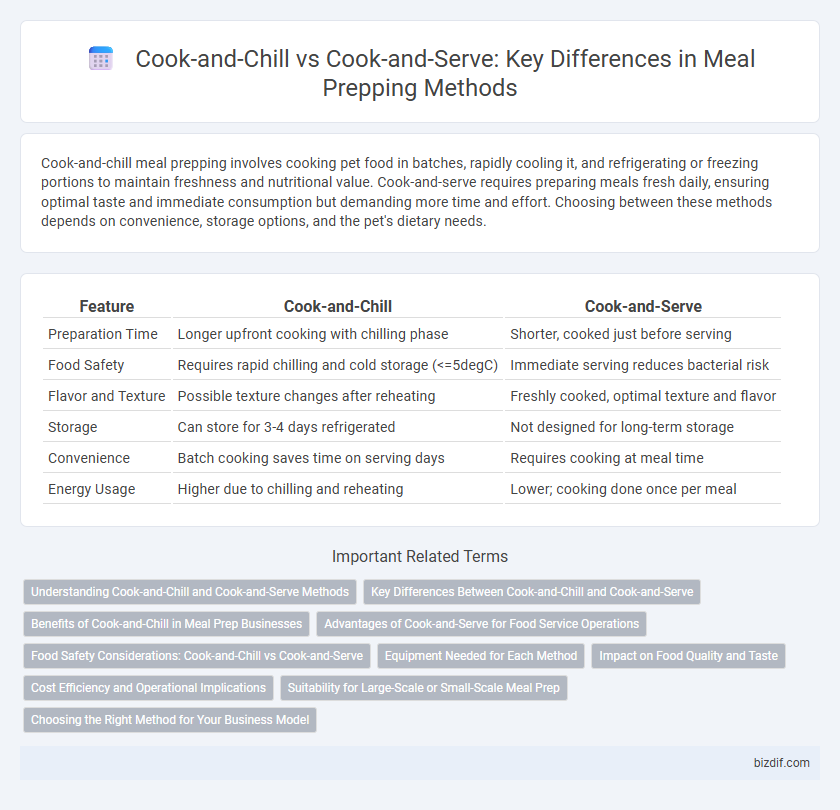Cook-and-chill meal prepping involves cooking pet food in batches, rapidly cooling it, and refrigerating or freezing portions to maintain freshness and nutritional value. Cook-and-serve requires preparing meals fresh daily, ensuring optimal taste and immediate consumption but demanding more time and effort. Choosing between these methods depends on convenience, storage options, and the pet's dietary needs.
Table of Comparison
| Feature | Cook-and-Chill | Cook-and-Serve |
|---|---|---|
| Preparation Time | Longer upfront cooking with chilling phase | Shorter, cooked just before serving |
| Food Safety | Requires rapid chilling and cold storage (<=5degC) | Immediate serving reduces bacterial risk |
| Flavor and Texture | Possible texture changes after reheating | Freshly cooked, optimal texture and flavor |
| Storage | Can store for 3-4 days refrigerated | Not designed for long-term storage |
| Convenience | Batch cooking saves time on serving days | Requires cooking at meal time |
| Energy Usage | Higher due to chilling and reheating | Lower; cooking done once per meal |
Understanding Cook-and-Chill and Cook-and-Serve Methods
Cook-and-chill involves cooking food, rapidly cooling it to below 5degC within two hours, and storing it safely to preserve freshness and prevent bacterial growth. Cook-and-serve requires preparing and cooking meals immediately before consumption, ensuring optimal flavor and texture but less flexibility in timing. Choosing between cook-and-chill and cook-and-serve depends on meal volume, timing, and food safety priorities in meal prepping.
Key Differences Between Cook-and-Chill and Cook-and-Serve
Cook-and-Chill involves cooking food, rapidly cooling it to below 3degC, and storing it for later reheating, ensuring extended shelf life and reduced food waste. Cook-and-Serve requires immediate serving after cooking, emphasizing freshness but limiting preparation flexibility and holding time. Key differences include food safety protocols, storage duration, and operational efficiency, with Cook-and-Chill allowing batch preparation and Cook-and-Serve focusing on immediate consumption.
Benefits of Cook-and-Chill in Meal Prep Businesses
Cook-and-chill technology extends the shelf life of pre-cooked meals by rapidly cooling them to safe temperatures, significantly reducing food waste and enhancing food safety compliance in meal prep businesses. This method allows for efficient portion control and inventory management, supporting scalability and consistent product quality. Cook-and-chill also enables better nutrient retention and flavor preservation compared to traditional cook-and-serve, optimizing customer satisfaction and operational efficiency.
Advantages of Cook-and-Serve for Food Service Operations
Cook-and-Serve offers food service operations rapid food delivery by minimizing advance preparation time and ensuring dishes are served fresh. This method enhances menu flexibility, allowing chefs to adjust portions and customize meals based on daily demand. It also reduces storage requirements and lowers the risk of food quality degradation compared to Cook-and-Chill processes.
Food Safety Considerations: Cook-and-Chill vs Cook-and-Serve
Cook-and-chill meal prepping requires rapid cooling of cooked food to below 5degC within two hours to inhibit bacterial growth and ensure safe storage, while cook-and-serve involves serving food immediately after cooking, minimizing the time food spends in the temperature danger zone of 5degC to 60degC. Proper hygiene, temperature monitoring, and adherence to USDA guidelines are critical in both methods to prevent contamination and foodborne illnesses. Implementing HACCP protocols enhances food safety by identifying and controlling hazards specific to each preparation technique.
Equipment Needed for Each Method
Cook-and-chill meal prepping requires equipment such as blast chillers or rapid coolers, airtight storage containers, and refrigeration units to safely store meals at low temperatures. Cook-and-serve relies on ovens, stovetops, and heated holding cabinets to prepare and maintain food warmth until serving. Both methods benefit from food thermometers to ensure safe cooking temperatures and maintain quality.
Impact on Food Quality and Taste
Cook-and-Chill preserves food quality by rapidly cooling meals to lock in freshness, texture, and flavor, reducing microbial growth and maintaining optimal taste over extended storage. Cook-and-Serve offers immediate consumption benefits with peak freshness and flavor but may suffer from inconsistent temperature control and faster quality degradation if not served promptly. The choice between methods impacts texture retention, nutrient stability, and overall taste experience, with Cook-and-Chill being ideal for bulk preparation and Cook-and-Serve excelling in immediate, high-quality meal delivery.
Cost Efficiency and Operational Implications
Cook-and-chill meal prepping reduces labor costs by allowing bulk cooking and extended shelf life through rapid cooling and refrigerated storage, minimizing food waste and enabling flexible serving times. In contrast, cook-and-serve requires immediate preparation and serving, increasing labor demands and limiting inventory control, which can drive higher operational expenses. Facilities adopting cook-and-chill benefit from streamlined workflows, improved portion control, and lower energy costs associated with less frequent cooking cycles.
Suitability for Large-Scale or Small-Scale Meal Prep
Cook-and-chill is ideal for large-scale meal prep, allowing meals to be cooked in bulk, rapidly cooled, and stored safely for extended periods, making it suitable for institutions and catering services. Cook-and-serve caters to small-scale meal preparation where freshly cooked meals are served immediately, ensuring optimal flavor and temperature for individual or household consumption. Large facilities benefit from the efficiency and safety of cook-and-chill, while cook-and-serve supports flexibility and quality for smaller meal quantities.
Choosing the Right Method for Your Business Model
Cook-and-chill offers extended shelf life and better inventory control, making it ideal for businesses with high volume and advance preparation needs. Cook-and-serve suits establishments prioritizing freshness and immediate consumption, reducing storage requirements and ensuring optimum taste. Selecting the right method depends on your business's scale, service speed, and customer preferences, balancing operational efficiency with quality delivery.
Cook-and-Chill vs Cook-and-Serve Infographic

 bizdif.com
bizdif.com